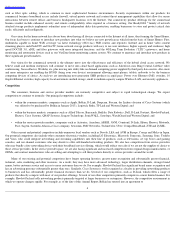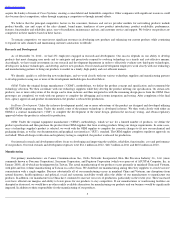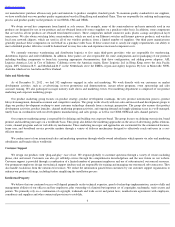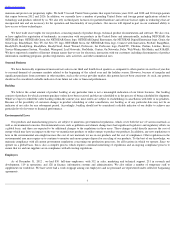Netgear 2012 Annual Report Download - page 18
Download and view the complete annual report
Please find page 18 of the 2012 Netgear annual report below. You can navigate through the pages in the report by either clicking on the pages listed below, or by using the keyword search tool below to find specific information within the annual report.
Table of Contents
We have experienced delays and quality issues in releasing new products in the past, which resulted in lower quarterly net revenue than
expected. In addition, we have experienced, and may in the future experience, product introductions that fall short of our projected rates of market
adoption. Online Internet reviews of our products are increasingly becoming a significant factor in the success of our new product launches,
especially in the retail business unit. If we are unable to quickly respond to negative reviews, including end user reviews posted on various prominent
online retailers, our ability to sell these products will be harmed. Any future delays in product development and introduction, or product introductions
that do not meet broad market acceptance, or unsuccessful launches of newly acquired product lines could result in:
Throughout the past couple of years, we have significantly increased the rate of our new product introductions. If we cannot sustain the rapid
pace of innovation or acquire new product lines, we may not be able to maintain or increase the market share of our products. In addition, if we are
unable to successfully introduce or acquire new products with higher gross margins, our net revenue and overall gross margin would likely decline.
We obtain several key components from limited or sole sources, and if these sources fail to satisfy our supply requirements or we are unable
to properly manage our supply requirements with our third party manufacturers, we may lose sales and experience increased component
costs.
Any shortage or delay in the supply of key product components would harm our ability to meet scheduled product deliveries. Many of the
semiconductors used in our products are specifically designed for use in our products and are obtained from sole source suppliers on a purchase order
basis. In addition, some components that are used in all our products are obtained from limited sources. These components include connector jacks,
plastic casings and physical layer transceivers. We also obtain switching fabric semiconductors, which are used in our Ethernet switches and Internet
gateway products, and wireless local area network chipsets, which are used in all of our wireless products, from a limited number of suppliers.
Semiconductor suppliers have experienced and continue to experience component shortages themselves, such as with substrates used in
manufacturing chipsets, which in turn adversely impact our ability to procure semiconductors from them. Our third-
party manufacturers generally
purchase these components on our behalf on a purchase order basis, and we do not have any contractual commitments or guaranteed supply
arrangements with our suppliers. If demand for a specific component increases, we may not be able to obtain an adequate number of that component
in a timely manner. In addition, if worldwide demand for the components increases significantly, the availability of these components could be
limited. Further, our suppliers may experience financial or other difficulties as a result of uncertain and weak worldwide economic conditions. Other
factors which may affect our suppliers' ability to supply components to us include internal management or reorganizational issues, such as roll-
out of
new equipment which may delay or disrupt supply of previously forecasted components. It could be difficult, costly and time consuming to obtain
alternative sources for these components, or to change product designs to make use of alternative components. In addition, difficulties in transitioning
from an existing supplier to a new supplier could create delays in component availability that would have a significant impact on our ability to fulfill
orders for our products.
We provide our third-
party manufacturers with a rolling forecast of demand, which they use to determine our material and component
requirements. Lead times for ordering materials and components vary significantly and depend on various factors, such as the specific supplier,
contract terms and demand and supply for a component at a given time. Some of our components have long lead times, such as wireless local area
network chipsets, switching fabric chips, physical layer transceivers, connector jacks and metal and plastic enclosures. If our forecasts are not timely
provided or are less than our actual requirements, our third-
party manufacturers may be unable to manufacture products in a timely manner. If our
forecasts are too high, our third-
party manufacturers will be unable to use the components they have purchased on our behalf. The cost of the
components used in our products tends to drop rapidly as volumes increase and the technologies mature. Therefore, if our third-
party manufacturers
are unable to promptly use components purchased on our behalf, our cost of producing products may be higher than our competitors due to an
oversupply of higher-
priced components. Moreover, if they are unable to use components ordered at our direction, we will need to reimburse them
for any losses they incur.
14
•
loss of or delay in revenue and loss of market share;
•
negative publicity and damage to our reputation and brand;
•
a decline in the average selling price of our products;
•
adverse reactions in our sales channels, such as reduced shelf space, reduced online product visibility, or loss of sales channel; and
•
increased levels of product returns.
























